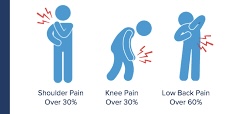 Inappropriate diagnostic imaging refers to the use of imaging studies that do not align with established clinical guidelines or evidence-based criteria.
Inappropriate diagnostic imaging refers to the use of imaging studies that do not align with established clinical guidelines or evidence-based criteria.
Inappropriate diagnostic imaging leads to unnecessary procedures, increased healthcare costs, and potential patient harm.
Inappropriate diagnostic imaging (IDI) refers to medical imaging tests that are unnecessary, redundant, or unlikely to benefit patient care.
Several factors contribute to inappropriate imaging:
Lack of Adherence to Guidelines
2. Physician Characteristics: Less experienced physicians and those in primary care are more likely to order inappropriate imaging compared to specialists.[2]
3. Self-Referral: Although self-referral can still contribute to inappropriate imaging when physicians order tests that they or their group will perform.
Defensive Medicine: Ordering imaging studies to avoid potential litigation rather than based on clinical necessity can lead to overutilization.
Patient Expectations: Patients often expect imaging studies, which can pressure physicians to order unnecessary tests.
Inadequate Clinical Information: Imaging requests lacking sufficient clinical justification or those that do not match clinical scenarios described in guidelines are inappropriate.
Repetition of Tests: Repeating imaging studies without a clear clinical indication or within an inappropriate timeframe also constitutes inappropriate use.
IDI is associated with: Radiation Exposure: CT scans and X-rays expose patients to ionizing radiation, which has cumulative effects over time.
Healthcare Costs: Unnecessary imaging significantly contributes to rising healthcare expenses
False Positives: Can lead to anxiety, additional testing, and potentially invasive procedures
Resource Allocation: Reduces availability of imaging resources for patients who truly need them
Incidental Findings: Can detect abnormalities unrelated to the clinical question that may lead to cascades of further testing
Inappropriate Imaging seen with:
Routine imaging for uncomplicated headaches without red flags Advanced imaging for acute low back pain without warning signs Annual full-body CT scans for asymptomatic individuals Repeated CT scans when prior results are available Chest X-rays for routine pre-operative assessment in low-risk patients CT for minor head trauma in low-risk patients Imaging for acute rhinosinusitis before trying medical therapy
Choosing Wisely Initiatives: Many professional medical organizations have developed guidelines to reduce inappropriate imaging.
Prevalence estimates of inappropriate imaging: For lumbar spine MRIs, more than 60% were deemed inappropriate, and about 40% of lumbar spine X-rays were inappropriate within 30 days of the initial visit for uncomplicated low back pain.
Over 30% of MRIs for non-traumatic knee and shoulder pain were considered inappropriate.
In emergency departments, recent research found that 59.4% of ultrasounds, 29.1% of CT exams, and 33.3% of MR exams were inappropriate.
A systematic review found the prevalence of overuse of diagnostic imaging ranged from 0.09% to 97.5%, with a median prevalence of 11% using a patient-indication lens and 30.7% using a service lens.
The FDA has cited estimates that 20–50% of high-tech imaging procedures, such as CT scans, may not provide useful information for patient care.
